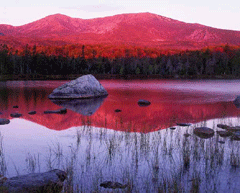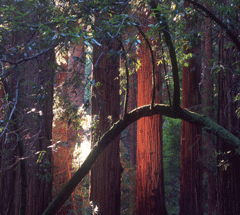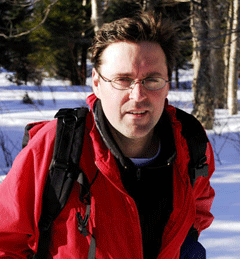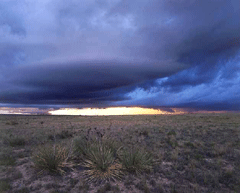Wildlands Philanthropy
Air Date: Week of January 16, 2009

Baxter State Park, in Maine. (Photo: © Antonio Vizcaino/America Natural)
Conserved lands like Muir Woods National Monument might be dear to American hearts, but few know about the people behind the places. Tom Butler, author of "Wildlands Philanthropy," tells host Steve Curwood about some of the love stories between America's wild places and the people who helped keep them wild.
Transcript
CURWOOD: Visitors to our country's majestic parks and nature preserves don't usually forget their experiences. Walking among the giant redwoods of Muir Woods National Monument or taking in the vast expanses of sky and land in Sevilleta National Wildlife Refuge... tend to leave a mark.
But the people who conserved these lands, are - for the most part - forgotten. Until now. Writer Tom Butler has researched America's conservation philanthropists... from the rich and famous like John D. Rockefeller Jr. to school teacher Mary Wharton - to members of conservation land trusts-- who collectively buy up local land to keep it protected. In collaboration with photographer Antonio Vizcaino, Mr. Butler compiled 40 of these stories into a new book called "Wildlands Philanthropy: The Great American Tradition." Tom, thanks for joining me.
BUTLER: Thank you very much.
CURWOOD: Why did you write this book?

Baxter State Park, in Maine. (Photo: © Antonio Vizcaino/America Natural)
BUTLER: There are thousands of wild places, protected natural areas, literally from sea to shining sea, from Alaska to Tierra del Fuego, across the country and around the world, and this tradition of wildlands philanthropy is something that has profoundly affected the American experience – millions of us. We take our children to the Smokies to go camping or we stroll among the cobble beaches of Acadia National Park. We enjoy these places, which in many cases have come to embody our very idea of America the Beautiful. And yet relatively few people have any idea that there were people – individuals or small groups – using their own private passion and energy and time and personal wealth to save these places for the future.
CURWOOD: Your book begins with Muir Woods National Monument and probably for good reason because it's such an amazing place. You leave the clamor and clatter of San Francisco. You drive over the Golden Gate Bridge and it doesn't take you very long to be really, I think, one of the most amazing places on earth. The height of the redwoods is like being in a cathedral or something, and I was surprised to learn that it wasn't the conservationist John Muir who was behind the conservation there, but this couple William and Elizabeth Thatcher Kent. They were also responsible for an adjoining state park. Who were these people?

Muir Woods National Monument, in California. (Photo: © Antonio Vizcaino/America Natural)
BUTLER: William and Elizabeth Thatcher Kent were a progressive Marin County couple who in 1905 bought the very last tract of old growth coast redwoods that existed in the San Francisco Bay area. All the others had been logged out. Well, a private utility developer approached William Kent and offered to buy his land. He wanted to skim off the giant trees, dam Redwood Creek and create a private reservoir. And Kent realized that fighting the eminent domain process that the developer had commenced was likely to be difficult. And so he circumvented the developer. He bundled up the deeds to about 295 acres including that great cathedral grove in Muir Woods and sent it off to the secretary of the interior, who was Garfield, and asked that President Teddy Roosevelt use the Antiquities Act and declare a national monument. And he specifically asked that it be named for that great early wilderness conservationist, John Muir. And Teddy Roosevelt did just that. But he also wrote Kent back a letter and said essentially this is a grand gift and a wonderful thing you've done, but shouldn't we name it Kent National Monument because you're the one giving the land? And William Kent wrote the President back and said “I've got four rugged boys that I'm raising up to be manly men like you, Mr. President, and if they can't keep the name Kent alive, then I'm content it should be forgotten.”

Author Tom Butler. (Photo: © Antonio Vizcaino/America Natural)
[LAUGHING]
BUTLER: And moreover, he didn't want to – and here I'll quote directly – he didn't want “to stencil one's own name upon a benefaction.”
CURWOOD: Now, going through your book, Tom, many of the stories involve folks who – well, frankly, they had a lot of dough. And I think the Kents were a fairly affluent family who could afford to write a check for this amazing piece of old growth, but you also have a story in here about a couple of women who, well, put a preserved area on their credit cards.
[LAUGHING]
CURWOOD: This is the fresh tracks story.

Fresh Tracks Nature Preserve, in Colorado. (Photo: © Antonio Vizcaino/America Natural)
BUTLER: This was just a few years ago. Two amazing young women, they were graduate students at the University of Colorado. And in between their studies they were also conservation activists, particularly with an animal defense group that was busy trying to prevent the sort of horrific prairie dog massacres that were then legal in Colorado, where gunners would go out to a prairie dog town and blast away and turn the little prairie dogs – which are, of course, a keystone species in the short grass prairie ecosystem – they would turn them into a fine red mist. There was even a sort of red mist subculture. Well, these two young activists were among a group that would go and try to block these prairie dogs shoots by chaining themselves with bike locks or the like in front of the gunners. And time after time they would get hauled away by the police. And on one long holiday weekend, they were sitting in the Kit Carson County Jail, in Colorado, and they began thinking, well what can we do to more effectively protect these creatures and this habitat that we love? And they founded a land trust. They raised money, they used credit card - initially – debt to help pay off the mortgage payments on a tract of about 1200 acres of short grass prairie in eastern Colorado which they bought and protected as the Fresh Tracks Nature Preserve.
CURWOOD: Tom, I want to ask you, how important has the local land trust movement been to conservation?
BUTLER: Incredibly important. I would say that the growth of the land trust movement is one of the most hopeful trends in our entire national experience. You don't need to be a Rockefeller anymore. There are opportunities for Americans in virtually every community, from every type of background, to engage in this tradition of wildlands philanthropy, to help continue it, expand it, invigorate it for the next century.
CURWOOD: Tom Butler wrote the essays in the new book “Wildlands Philanthropy: The Great American Tradition” which he did with photographer Antonio Vizcaino. The photographs in it, by the way, are just exquisite. And you can see a few of them, by the way, at our website at loe.org. Tom Butler, thank you so much for taking this time.
BUTLER: You're very welcome. Thank you.
Links
For more on Tom Butler’s book “Wildlands Philanthropy,” click here
Living on Earth wants to hear from you!
Living on Earth
62 Calef Highway, Suite 212
Lee, NH 03861
Telephone: 617-287-4121
E-mail: comments@loe.org
Newsletter [Click here]
Donate to Living on Earth!
Living on Earth is an independent media program and relies entirely on contributions from listeners and institutions supporting public service. Please donate now to preserve an independent environmental voice.
NewsletterLiving on Earth offers a weekly delivery of the show's rundown to your mailbox. Sign up for our newsletter today!
 Sailors For The Sea: Be the change you want to sea.
Sailors For The Sea: Be the change you want to sea.
 The Grantham Foundation for the Protection of the Environment: Committed to protecting and improving the health of the global environment.
The Grantham Foundation for the Protection of the Environment: Committed to protecting and improving the health of the global environment.
 Contribute to Living on Earth and receive, as our gift to you, an archival print of one of Mark Seth Lender's extraordinary wildlife photographs. Follow the link to see Mark's current collection of photographs.
Contribute to Living on Earth and receive, as our gift to you, an archival print of one of Mark Seth Lender's extraordinary wildlife photographs. Follow the link to see Mark's current collection of photographs.
 Buy a signed copy of Mark Seth Lender's book Smeagull the Seagull & support Living on Earth
Buy a signed copy of Mark Seth Lender's book Smeagull the Seagull & support Living on Earth

